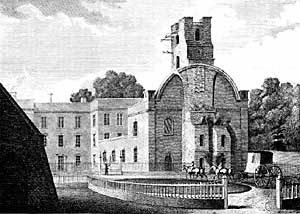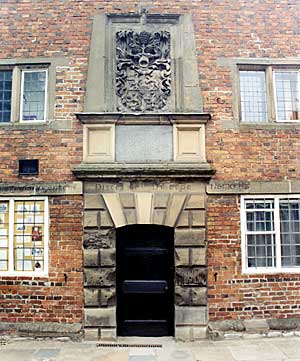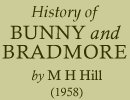List of Rectors and Vicars of Bunny and Bradmore
(From 1228 to the present day)
|
RECTORS |
1228 |
Robert de Glamorgan. Patron: Chapter of Southwell. |
1270 |
Henry de Grey. Patron: Guardian of son of Anker de Freschvi |
1288 |
William Heccredibre. |
1299 |
William de Langley. Patron: Ralph de Freschville. |
13— |
Robert de Dereford. Patron: Robert de Wodehouse. |
1319 |
John de Horeton. Patron: Robert de Wodehouse. |
1340 |
Hamo de Belers. Patron: Robert Wodehouse. |
|
VICARS |
1365 |
William de Churchesley. Patron: Prior and Convent of Ulverscroft. |
1410 |
William Snow. Patron: Prior and Convent of Ulverscroft. |
1419 |
Thomas Wareyn. Patron: Prior and Convent of Ulverscroft. |
1426 |
John de Hynton. Patron: Prior and Convent of Ulverscroft. |
1428 |
Thomas Waryn. Patron: Prior and Convent of Ulverscroft. |
1434 |
John Haryt. Patron: Prior and Convent of Ulverscroft. |
1485 |
Robert Kynston. Patron: Prior and Convent of Ulverscroft. |
1486 |
Richard Brayston. Patron: Prior and Convent of Ulverscroft. |
1487 |
Henry Boond. Patron : Prior and Convent of Ulverscroft. |
1500 |
Thomas Thorpe. Patron : Prior and Convent of Ulverscroft. |
1506 |
William Barker. Patron : Prior and Convent of Ulverscroft. |
1541 |
Edmund Randall. Patron : Prior and Convent of Ulverscroft. |
1550 |
Henry Rawdon. Patron : King Edward VI. |
1560 |
(approx.) John Drewyne. |
1593 |
Richard Fowler. Patron : Richard Parkyns. |
1636 |
Samuel Lightfoot. Patron: Isham Parkyns. |
|
Charles Wainwright. (Buried at Bunny—date uncertain). |
1690 |
Henry Twinbury. Patron : Sir Thomaseta. |
1690 |
Henry Twinbury. Patron : Sir Thomas Parkyns. |
1701 |
Daniel Fernshough (buried in south aisle, Bunny). Patron : Sir Thomas Parkyns. |
1714 |
Thomas Poynton (buried at Bunny). Patron : Sir Thomas Parkyns. |
1765 |
Luke Stephenson. Patron : Sir Thomas Parkyns. |
1771 |
William Nelson (buried at Bunny). Patron : Sir Thomas Parkyns. |
1785 |
William Beetham. Patron : Sir Thomas Parkyns. |
1800 |
William Bayley Cocker. Patron : Sir Thomas Parkyns. |
1823 |
John Tidy Beetham. Patron : Revd. William Beetham. |
1864 |
Henry John Hoskyns. Patron : Samuel Bagnali Wild. |
1868 |
Rev. Alfred Cory Kingdom. Patron : Mrs. Harriett Forteath. |
1893 |
Rev. Herbert Cooper. Patron : Miss Arabella Hawksley. |
1901 |
Rev. S. G. 0. Anderson. Patron : Mrs. Wilkinson Smith. |
1908 |
Rev. Dr. C. D. Powell (in charge three years). |
1911 |
Rev. S. G. 0. Anderson (again). |
1920 |
Rev. J. F. Kahn. Patron: Sir Albert Ball. |
1933 |
Rev. J. L. Street. Patron: Sir Albert Ball. |
1935 |
Rev. J. R. Harrison. Patron: Sir Albert Ball. |
1946 |
Rev. W. R. Hughes. Patron: Sir Albert Ball. |
1947 |
Rev. W. N. Metcalfe. Patron: Lady Ball. |
The organ was bought in 1905. The cost, £252, was raised by subscription. Mrs. Cordeux had it properly built, enlarged and placed on the south side of the chancel, in memory of her husband, Dr. R. H. Cordeux, and her son, Lieutenant E. N. Cordeux. An electric blower was installed by Mrs. Cordeux's daughters in memory of their mother.
A prayer book for the church was given by the Miss Pyatts and a new pulpit desk by Dr. R. H. Cordeux.
The lectern is in memory of Mrs. Wilkinson Smith, and the prayer desk of Mr. Walter Smeeton, a churchwarden, and a very good worker in this parish.
An altar rail (adapted from the ancient old railing formerly over the chancel vault), a new altar, a brass cross, two stone steps to the altar, and a set of vestings for the different seasons, were given by Mrs. Wilkinson Smith, at an expenditure of £800.
In 1907 the church workers provided £36 17s. for the Kneeler Funder, and two years later they raised £41 for the choir stalls.
The Bishop of Southwell consecrated the ground for the extension of the churchyard given by Sir Albert Ball in 1910, in 1912, the re-opening of the church and dedication quoting:
"If our Parish Church has stood for 800 years it now has been so repaired as to warrant the hope that it will last as long in the future." Mrs. Wilkinson Smith left £1,000 for this.

The tower at Bunny Hall in 1790.
The Hall Tower was built and designed by Sir Thomas Parkyns, the wrestler. He also re-built a great part of the hall, which used to be called Bunney House. The coat of arms on the tower is that of Parkyns impaling Cressy.
There is an extensive view of the surrounding country from the tower. When Sir Thomas Parkyns was too old for hunting he used to don his "pink" and watch the hounds meet and take off across the Park from his high position on the tower.
The Park is large and extensive, bound on the south side by the Fairham Brook. The principal gateway faces east but the use of this has been discontinued for many years.
You see the stone pine apples still standing in lonely dignity under the shade of the trees.
Rancliffe Wood, now only small trees, is on a hill.
The Long Plantation runs on the north side of the Park. The woods on the rising ground east and west of Bunny Hill were cut down some years ago. The hill was considerably lowered and one can see how high it originally was by the height of the bank on the right hand side going to Loughborough.
The Grange is a large and well built residence, and one of the dower houses at one time. It is rather interesting to read the following words scratched on one of the Grange windows :
Nellie Craven,
Wakefield Hall,
Staffs. 1867.
The Rancliffe Arms is a picturesque old inn on the main road from Nottingham to London. We are told that plays were acted in this inn yard.
A piece of ground close to this inn was used sometimes for wrestling matches in the time of Sir Thomas Parkyns. A Roman bowl of the first century was dug up in this ground in 1947. It is now in the Castle Museum, as before mentioned.

Entrance to the Old School, Bunny (photo: A. Nicholson, 2003).
The old school is of interest to many, with its stone corners, mullioned windows, and heavy beams, standing in a commanding place at the church gates. It is now used as an Institute (the Church Institute) and is very useful for the young men of the village for various games. The other rooms are used for aged persons—and now one room is a "clinic" for the babies.
High Fields used to be a dower house for the hall family. It is now a farm house and strong enough for a fortification; overlooking the village of Costock and standing back from the main road.
It is interesting to glance through Professor Pryme's autobiography.
We read that in the summer of 1792 George Pryme was placed with the Rev. William Beetham, Vicar of Bunny, for scholastical instruction. He was the first pupil.
In George Pryme's biography it is interesting to read that he was a descendant on the female side of the Metcalfes of Nappa Hall, Wensleydale, Yorkshire, and also that the present Vicar, the Rev. W. N. Metcalfe, is a descendant of this ancient family.
At that time Bunny was a countryside of fields and woods. Sir Thomas and Lady Parkyn lived at Bunny Hall. They dined at 2 o'clock, had tea at 6, and supper at 9.
Sir Thomas drove four horses. His walled deer park contained two deer leaps.
Sherwood Forest was eight miles distant. When the hunters chased the deer to the edge of the deer leap, which was elevated on the outside, and hollowed within, the animal taking this leap became the property of the owner of the park.
Dr. Beetham sent George Pryme one day to ask why the church bells were ringing and found out it was because of Admiral Howe's victory over the Brest Fleet, June 1, 1794. This boy first heard Gray's Elegy at Bunny, and he saw the dancing around the maypole at Bradmore. There was a weaver at this time at Bunny who was also the parish clerk. His workshop was open to the street. Every cottage and farmhouse had a spinning wheel at this period.
Humphrey Wainwright, of Bunny, was a good clock maker. In memorials of " Old Notts." we see an illustration of one clock of his which plays a tune every three hours.
John Robinson, the master of the village school, wrote a book of poems and local events. It was dedicated to Lord Rancliffe.
Just to quote one thing he noted (the descendants of whom still live in Bradmore) :
"Died at Bradmore on Friday, 1825, highly respected by all who knew her, full of years, and full of hope, having lived nearly a century, being in her 99th year, Catherine, widow of Mr. James Dalby, miller and cottager."
